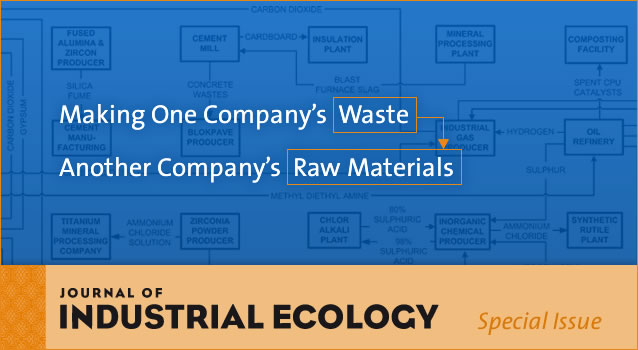Making One Company’s Waste Another Company’s Raw Materials
 Making one company’s waste another company’s raw material has long been one of the most intriguing notions in industrial ecology. This strategy known as industrial symbiosis — by analogy to the manner in which some species in nature cooperate to mutual advantage — came to public attention in the early 1990s. An industrial district in Denmark with a dense web of resource sharing and by-product exchanges was discovered. Efforts to replicate the Danish example led to a search for other examples and strategies to create such industrial networks. Twenty years later, numerous examples have been documented and countries from China and Korea to the UK have embarked on programs to establish or facilitate industrial by-product exchange. A special issue of Yale’s Journal of Industrial Ecology highlights research that moves beyond case studies to couple empirical research with theory-building.
To complement the special issue, a selection of previously published articles on industrial symbiosis has been compiled at http://jie.yale.edu/symbiosis.
Making one company’s waste another company’s raw material has long been one of the most intriguing notions in industrial ecology. This strategy known as industrial symbiosis — by analogy to the manner in which some species in nature cooperate to mutual advantage — came to public attention in the early 1990s. An industrial district in Denmark with a dense web of resource sharing and by-product exchanges was discovered. Efforts to replicate the Danish example led to a search for other examples and strategies to create such industrial networks. Twenty years later, numerous examples have been documented and countries from China and Korea to the UK have embarked on programs to establish or facilitate industrial by-product exchange. A special issue of Yale’s Journal of Industrial Ecology highlights research that moves beyond case studies to couple empirical research with theory-building.
To complement the special issue, a selection of previously published articles on industrial symbiosis has been compiled at http://jie.yale.edu/symbiosis.
The Journal of Industrial Ecology is a peer-reviewed, international bimonthly journal that examines the relationship between industry and the environment from the perspective of the growing field of industrial ecology. It is owned by Yale, headquartered at the Yale School of Forestry & Environmental Studies, and published by Wiley-Blackwell.
And visit BPS-Hub.org to learn about the US BCSD's industrial ecology work.
